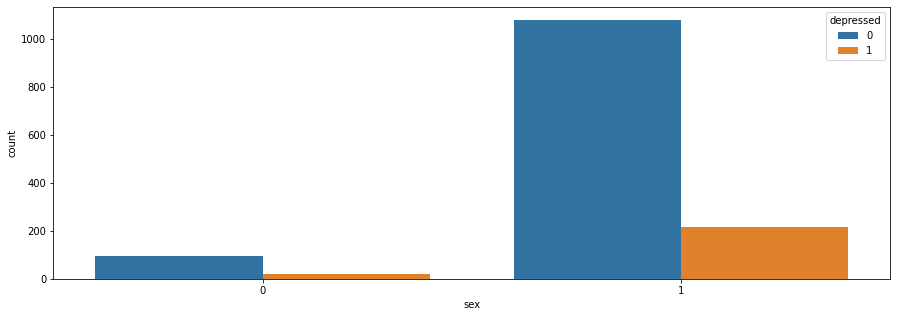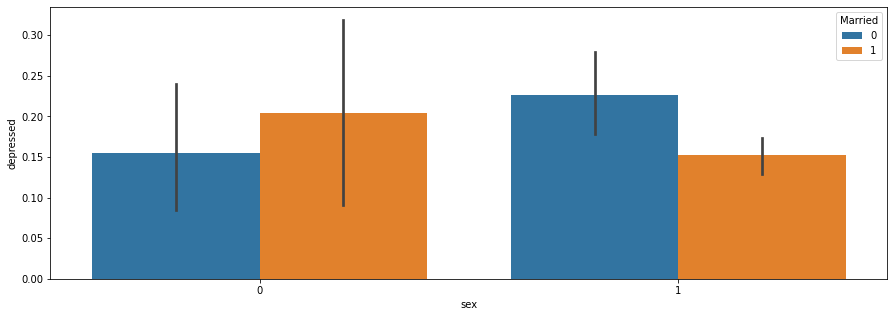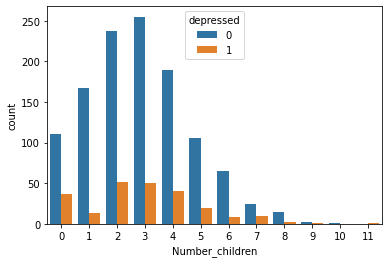Depression Prediction
Contents
Depression Prediction¶
Author: Tong Su
Course Project, UC Irvine, Math 10, S22
Introduction¶
As a psychology major student, I would like to use the dataset of depression importing from Kaggle to explore the socioeconomic factors that can predict the rate of rural residents being diagonosed as depression by using scikit learn.
Main portion of the project¶
(You can either have all one section or divide into multiple sections)
import numpy as np
import pandas as pd
import seaborn as sns
import altair as alt
import matplotlib.pyplot as plt
from sklearn.preprocessing import StandardScaler
from sklearn.linear_model import LinearRegression, LogisticRegression
from sklearn.neighbors import KNeighborsClassifier
from sklearn.model_selection import train_test_split
from sklearn.metrics import mean_squared_error, mean_absolute_error, log_loss
Basic info about the dataset¶
df = pd.read_csv('b_depressed.csv')
df.head()
| Survey_id | Ville_id | sex | Age | Married | Number_children | education_level | total_members | gained_asset | durable_asset | ... | incoming_salary | incoming_own_farm | incoming_business | incoming_no_business | incoming_agricultural | farm_expenses | labor_primary | lasting_investment | no_lasting_investmen | depressed | |
|---|---|---|---|---|---|---|---|---|---|---|---|---|---|---|---|---|---|---|---|---|---|
| 0 | 926 | 91 | 1 | 28 | 1 | 4 | 10 | 5 | 28912201 | 22861940 | ... | 0 | 0 | 0 | 0 | 30028818 | 31363432 | 0 | 28411718 | 28292707.0 | 0 |
| 1 | 747 | 57 | 1 | 23 | 1 | 3 | 8 | 5 | 28912201 | 22861940 | ... | 0 | 0 | 0 | 0 | 30028818 | 31363432 | 0 | 28411718 | 28292707.0 | 1 |
| 2 | 1190 | 115 | 1 | 22 | 1 | 3 | 9 | 5 | 28912201 | 22861940 | ... | 0 | 0 | 0 | 0 | 30028818 | 31363432 | 0 | 28411718 | 28292707.0 | 0 |
| 3 | 1065 | 97 | 1 | 27 | 1 | 2 | 10 | 4 | 52667108 | 19698904 | ... | 0 | 1 | 0 | 1 | 22288055 | 18751329 | 0 | 7781123 | 69219765.0 | 0 |
| 4 | 806 | 42 | 0 | 59 | 0 | 4 | 10 | 6 | 82606287 | 17352654 | ... | 1 | 0 | 0 | 0 | 53384566 | 20731006 | 1 | 20100562 | 43419447.0 | 0 |
5 rows × 23 columns
df.info()
<class 'pandas.core.frame.DataFrame'>
RangeIndex: 1429 entries, 0 to 1428
Data columns (total 23 columns):
# Column Non-Null Count Dtype
--- ------ -------------- -----
0 Survey_id 1429 non-null int64
1 Ville_id 1429 non-null int64
2 sex 1429 non-null int64
3 Age 1429 non-null int64
4 Married 1429 non-null int64
5 Number_children 1429 non-null int64
6 education_level 1429 non-null int64
7 total_members 1429 non-null int64
8 gained_asset 1429 non-null int64
9 durable_asset 1429 non-null int64
10 save_asset 1429 non-null int64
11 living_expenses 1429 non-null int64
12 other_expenses 1429 non-null int64
13 incoming_salary 1429 non-null int64
14 incoming_own_farm 1429 non-null int64
15 incoming_business 1429 non-null int64
16 incoming_no_business 1429 non-null int64
17 incoming_agricultural 1429 non-null int64
18 farm_expenses 1429 non-null int64
19 labor_primary 1429 non-null int64
20 lasting_investment 1429 non-null int64
21 no_lasting_investmen 1409 non-null float64
22 depressed 1429 non-null int64
dtypes: float64(1), int64(22)
memory usage: 256.9 KB
Eliminate the null_values in “no_lasting_investmen”
df = df[~(df.no_lasting_investmen.isnull())]
Since the Survey_id and Ville_id are just the not relevant with the mental disorder so drop them.
df = df.drop(['Survey_id','Ville_id'],axis=1)
df.info()
<class 'pandas.core.frame.DataFrame'>
Int64Index: 1409 entries, 0 to 1428
Data columns (total 21 columns):
# Column Non-Null Count Dtype
--- ------ -------------- -----
0 sex 1409 non-null int64
1 Age 1409 non-null int64
2 Married 1409 non-null int64
3 Number_children 1409 non-null int64
4 education_level 1409 non-null int64
5 total_members 1409 non-null int64
6 gained_asset 1409 non-null int64
7 durable_asset 1409 non-null int64
8 save_asset 1409 non-null int64
9 living_expenses 1409 non-null int64
10 other_expenses 1409 non-null int64
11 incoming_salary 1409 non-null int64
12 incoming_own_farm 1409 non-null int64
13 incoming_business 1409 non-null int64
14 incoming_no_business 1409 non-null int64
15 incoming_agricultural 1409 non-null int64
16 farm_expenses 1409 non-null int64
17 labor_primary 1409 non-null int64
18 lasting_investment 1409 non-null int64
19 no_lasting_investmen 1409 non-null float64
20 depressed 1409 non-null int64
dtypes: float64(1), int64(20)
memory usage: 242.2 KB
df.describe()
| sex | Age | Married | Number_children | education_level | total_members | gained_asset | durable_asset | save_asset | living_expenses | ... | incoming_salary | incoming_own_farm | incoming_business | incoming_no_business | incoming_agricultural | farm_expenses | labor_primary | lasting_investment | no_lasting_investmen | depressed | |
|---|---|---|---|---|---|---|---|---|---|---|---|---|---|---|---|---|---|---|---|---|---|
| count | 1409.000000 | 1409.000000 | 1409.000000 | 1409.000000 | 1409.000000 | 1409.000000 | 1.409000e+03 | 1.409000e+03 | 1.409000e+03 | 1.409000e+03 | ... | 1409.000000 | 1409.000000 | 1409.000000 | 1409.000000 | 1.409000e+03 | 1.409000e+03 | 1409.000000 | 1.409000e+03 | 1.409000e+03 | 1409.000000 |
| mean | 0.918382 | 34.733854 | 0.774308 | 2.904897 | 8.697658 | 4.996451 | 3.360588e+07 | 2.707096e+07 | 2.744453e+07 | 3.248661e+07 | ... | 0.176011 | 0.254081 | 0.109297 | 0.264017 | 3.457400e+07 | 3.555012e+07 | 0.209368 | 3.300612e+07 | 3.360385e+07 | 0.166785 |
| std | 0.273879 | 13.800712 | 0.418186 | 1.872585 | 2.913673 | 1.772778 | 2.007839e+07 | 1.804276e+07 | 1.778911e+07 | 2.101274e+07 | ... | 0.380965 | 0.435498 | 0.312123 | 0.440965 | 2.091860e+07 | 2.126744e+07 | 0.407002 | 2.114974e+07 | 2.160228e+07 | 0.372916 |
| min | 0.000000 | 17.000000 | 0.000000 | 0.000000 | 1.000000 | 1.000000 | 3.251120e+05 | 1.625560e+05 | 1.729660e+05 | 2.629190e+05 | ... | 0.000000 | 0.000000 | 0.000000 | 0.000000 | 3.251120e+05 | 2.715050e+05 | 0.000000 | 7.429200e+04 | 1.263120e+05 | 0.000000 |
| 25% | 1.000000 | 25.000000 | 1.000000 | 2.000000 | 8.000000 | 4.000000 | 2.312976e+07 | 1.929852e+07 | 2.339998e+07 | 2.103352e+07 | ... | 0.000000 | 0.000000 | 0.000000 | 0.000000 | 2.295536e+07 | 2.239928e+07 | 0.000000 | 2.010056e+07 | 2.064203e+07 | 0.000000 |
| 50% | 1.000000 | 31.000000 | 1.000000 | 3.000000 | 9.000000 | 5.000000 | 2.891220e+07 | 2.286194e+07 | 2.339998e+07 | 2.669228e+07 | ... | 0.000000 | 0.000000 | 0.000000 | 0.000000 | 3.002882e+07 | 3.136343e+07 | 0.000000 | 2.841172e+07 | 2.829271e+07 | 0.000000 |
| 75% | 1.000000 | 42.000000 | 1.000000 | 4.000000 | 10.000000 | 6.000000 | 3.717283e+07 | 2.634528e+07 | 2.339998e+07 | 3.870381e+07 | ... | 0.000000 | 1.000000 | 0.000000 | 1.000000 | 4.003842e+07 | 4.399778e+07 | 0.000000 | 3.978445e+07 | 4.151762e+07 | 0.000000 |
| max | 1.000000 | 91.000000 | 1.000000 | 11.000000 | 19.000000 | 12.000000 | 9.912755e+07 | 9.961560e+07 | 9.992676e+07 | 9.929528e+07 | ... | 1.000000 | 1.000000 | 1.000000 | 1.000000 | 9.978910e+07 | 9.965119e+07 | 1.000000 | 9.944667e+07 | 9.965119e+07 | 1.000000 |
8 rows × 21 columns
Visualization¶
plt.figure(figsize=(15,5))
sns.countplot(x='sex',hue='depressed',data=df)
plt.show()

plt.figure(figsize=(15,5))
sns.barplot(x='sex',y='depressed',hue='Married',data=df)
plt.show()

sns.countplot(x='Number_children', hue='depressed', data=df)
<AxesSubplot:xlabel='Number_children', ylabel='count'>

plt.figure(figsize=(15,5))
sns.barplot(x='depressed',y='education_level',data=df)
plt.show()

sel = alt.selection_single(fields=["depressed"])
c1= alt.Chart(df).mark_circle().encode(
x="gained_asset",
y="living_expenses",
color=alt.Color('depressed')
)
c2= alt.Chart(df).mark_circle().encode(
x="incoming_agricultural",
y="lasting_investment",
color=alt.Color('depressed')
)
c1&c2
Based on graphs, we can basically have an intuition about the dataset. Indicated by the graph, unmarried men are more likely to be depressed than married men and married women are more likely to be depressed than unmarried women. The people not despressed distributes normarlly as the number of children they have and people do not have children are more likely to be depressed.
Correlation¶
plt.subplots(figsize=(15,10))
sns.heatmap(df.corr(), annot = True, fmt = ".2f")
plt.show()

Here is the correlation matrix for all the predictor variables and response variable. Notice that the correlation between labor_primary and incoming-salary is 0.90. This indicates that people with high incoming-salary tend to also have high labor primary.
Train_Test_Split¶
socioecon_state = ['gained_asset','durable_asset', 'save_asset', 'living_expenses', 'other_expenses','incoming_agricultural', 'farm_expenses', 'lasting_investment']
X = df[socioecon_state]
y = df['depressed']
scaler = StandardScaler()
scaler.fit(X)
StandardScaler()
X_train, X_test, y_train, y_test = train_test_split(X,y, test_size = .2)
clf = KNeighborsClassifier()
clf.fit(X_train, y_train)
KNeighborsClassifier()
df['pred_depressed'] = pd.Series(clf.predict(X_test))
log_loss(df['depressed'], clf.predict_proba(X))
0.7256651995634845
The log loss is not that high hence the model is proper for predicting depression.
pred_depression_type = (df[['depressed', 'pred_depressed']]).copy()
pdt = pred_depression_type.value_counts(normalize=True)
pdt
depressed pred_depressed
0 0.0 0.797101
1 0.0 0.184783
0 1.0 0.014493
1 1.0 0.003623
dtype: float64
Decision Tree¶
from sklearn.tree import DecisionTreeClassifier
from sklearn import tree
clf1 = DecisionTreeClassifier()
clf1.fit(df[socioecon_state],df["depressed"])
DecisionTreeClassifier()
clf1.score(df[socioecon_state],df["depressed"])
0.9460610361958836
fig = plt.figure(figsize=(200,100))
_ = tree.plot_tree(clf1,
feature_names=clf1.feature_names_in_
)

Restrict the maximum depth and maximum number of leaf nodes by instantiating a new classifier
clf2 = DecisionTreeClassifier(max_depth=10, max_leaf_nodes=20)
clf2.fit(df[socioecon_state],df["depressed"])
DecisionTreeClassifier(max_depth=10, max_leaf_nodes=20)
clf2.score(df[socioecon_state],df["depressed"])
0.8523775727466288
fig = plt.figure(figsize=(200,100))
_ = tree.plot_tree(clf2,
feature_names=clf2.feature_names_in_
)

Summary¶
In this project, I analyzed the datasets of rural residents’ depression. First, I created graphs to describe the distribution of depression regarding different factors. Some factors such as marriage, sex influence the probability of being depressed a lot and others such as education level do not impact the probability of being depressed a lot. Then, I presented the correlation between factors. Then, I used machine learning to analyze the dataset fitting data to see whether the numerical variables can predict being depressed. The last part is to build up decision tree for predicting depression and restricting the range of tree by setting up the max leaf nodes and max depth.
References¶
dataset source: https://www.kaggle.com/datasets/francispython/b-depression
